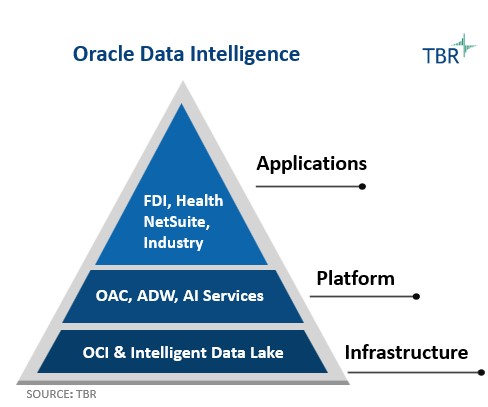Oracle Redefines Data Intelligence in Full-stack Approach
Oracle pivots around data intelligence, owing to its full-stack approach
Oracle has long offered a modern analytics stack tailored to multiple personas and workloads, such as through the Oracle Analytics Cloud (OAC) and Autonomous Data Warehouse (ADW), coupled with the operational data — where the true value exists — in Oracle’s Fusion, NetSuite and Industry Applications. But the 2023 launch of Fusion Data Intelligence (FDI) marked a major shift in Oracle’s analytics strategy and early vision for data intelligence, where data is used not only for static reporting of one-and-done use cases but also for continual predictive insights made possible by AI.
As a reminder, Oracle delivers FDI as a single-SKU application, an approach not all peers take, so Fusion customers are connected to their data through the quarterly Fusion updates, potentially causing minimal disruption to the workflow, which is an important enabler of data intelligence. From a technical perspective, FDI also comes with prebuilt AI and machine learning (ML) models, data science capabilities, and even its own separate set of intelligent applications (e.g., Supply Chain Command Center) that are persona-specific, allowing customers to act on a particular use case without leaving FDI, which is now the fastest-growing application across the entire Oracle corporation.
Importantly though, effective data intelligence is about not only the application but also the underlying architecture and whether it can effectively support structured and unstructured data for complex analytics use cases. We all know Oracle Cloud Infrastructure (OCI) has become a critical component of Oracle’s business, and because of the infrastructure layer, Oracle has a top-down advantage that many other players cannot provide.
The 2024 launch of Intelligent Data Lake reaffirmed how Oracle wants to further bridge the gap between applications and infrastructure, with an architecture that integrates with ADW and OAC. Essentially, Intelligent Data Lake is a reworking of existing OCI capabilities, such as cataloging and integration, to create a single abstraction layer that, in true data lake fashion, allows customers to query data on object storage, with support for popular data format frameworks including Apache Iceberg.
Many peers have been moving more squarely into the data lake space to make it easier for customers to build AI applications on top of a single copy of data. But in the case of Oracle, Intelligent Data Lake serves as the glue between the infrastructure and applications. With Intelligent Data Lake, Oracle has essentially redelivered its analytics tools as part of the Data Intelligence Platform, offering another key layer that could make the case for best-of-breed customers to consolidate more of their data and business intelligence estates on Oracle.
Regarding those application components, customers can leverage FDI as a single product, but this extends to NetSuite, Oracle Health (Cerner) and Industry Applications. For instance, last year Oracle launched Energy & Water Data Intelligence, leveraging insights from Industry Applications like Oracle Utilities Customer Cloud Service. More notably, as Oracle pivots around data intelligence, the company is taking steps to help customers access non-Oracle data sources.
For instance, last year Oracle launched a native Salesforce integration with FDI so customers can combine their CRM and Fusion data within the lakehouse architecture. This means Oracle customers can access Salesforce data with FDI the same way they can with Fusion. It will be interesting to see if Oracle more aggressively expands the data ecosystem in the future, particularly within the back office, to deliver FDI’s value to those outside the Oracle SaaS base.
FDI aligns with partners’ digital transformation ambitions
One of the compelling things about Oracle’s full-stack approach to analytics, from infrastructure up to applications, is that it prevents Oracle from getting caught up in a traditional BI RFP and instead enables the company to sell Oracle Data Intelligence as part of a broader enterprise transformation, which aligns with global systems integrators’ (GSIs) business models. Today, most of GSIs’ Oracle business comes from the applications side, and doing a Fusion SaaS implementation (e.g., ERP, HCM [human capital management]) and then introducing FDI to break down integration barriers and ultimately make those Fusion apps more “intelligent” appears to be a common motion.
In some cases, FDI is also displacing different components of a build-your-own data strategy. For example, we recently heard a compelling example from Infosys, which modernized a customer’s analytics stack by migrating from Snowflake and Informatica to FDI, which was then integrated with external systems, including NetSuite. In a scenario like this, it is clear that having a lot of data in the Oracle ecosystem can influence a customer’s decision to consolidate on FDI, but it also speaks to the role Oracle plays on the infrastructure side, as FDI address not only the analytics pieces but also the underlying data tasks, including the data pipelines, and absorb system-level tasks like ETL (Extract, Transform, Load).
Oracle’s full-stack approach to analytics makes a compelling case for consolidation, helping partners create value by eliminating disparate integrations and unlocking ROI. This is particularly true for partners that are perhaps willing to abandon the typical tech-agnostic approach and recommend Oracle as the primary choice from a data and analytics perspective. If Oracle engages a broader external data ecosystem in the future, as discussed above, partners will need to make sure they look beyond the applications layer and leverage Oracle’s broad PaaS and IaaS capabilities for custom development use cases.




